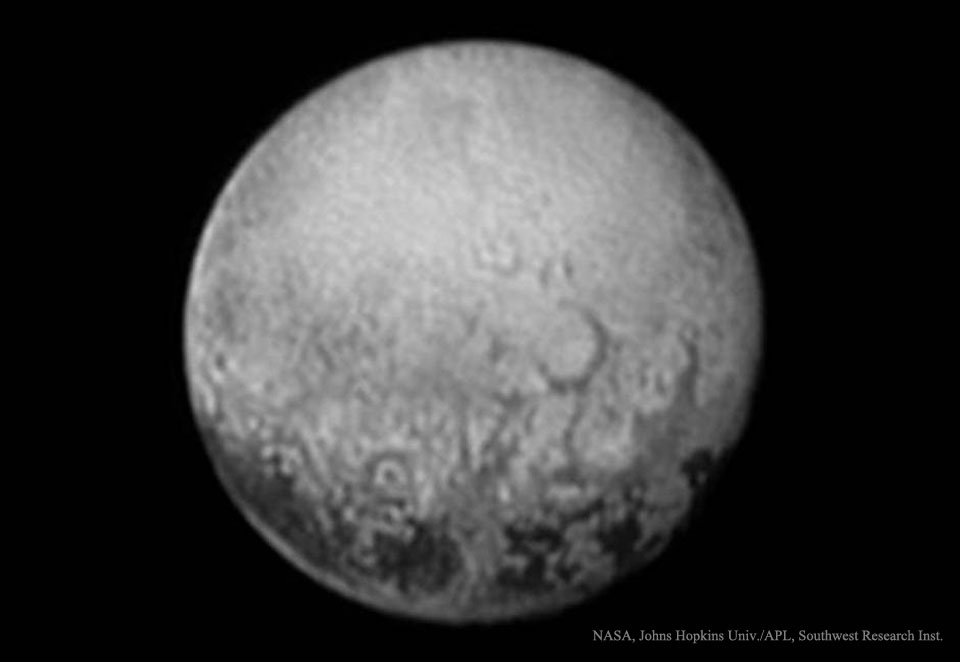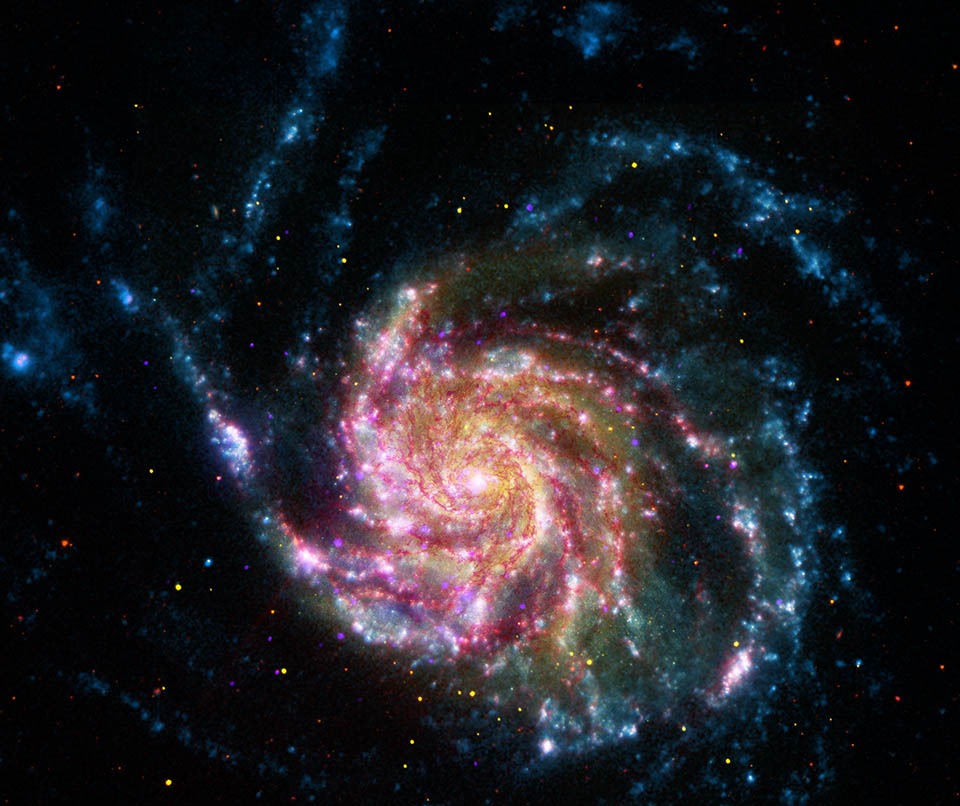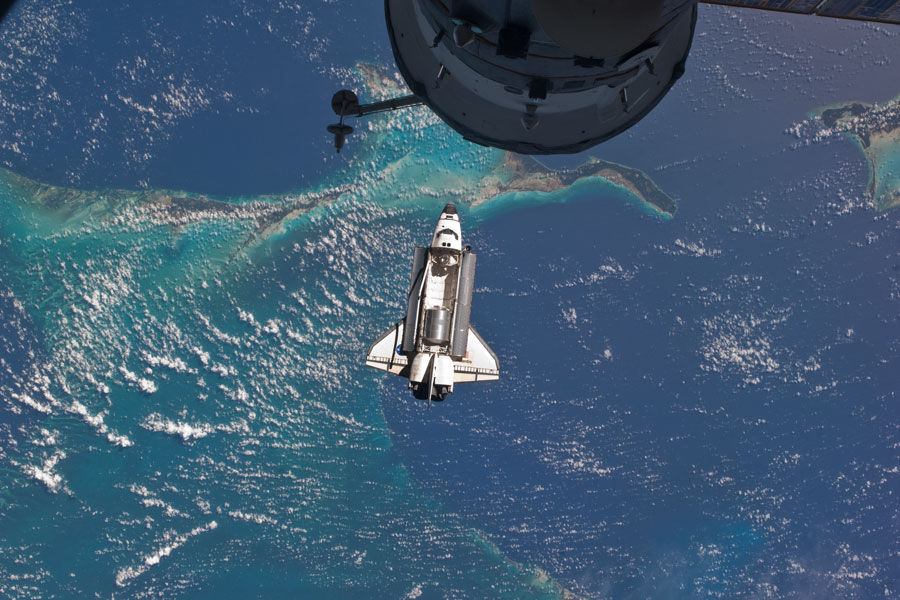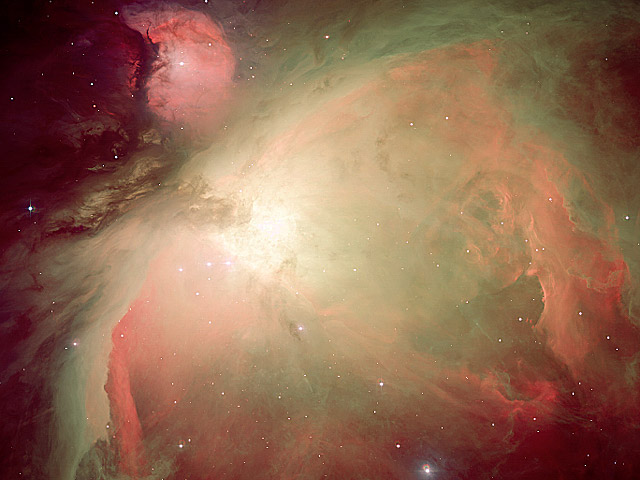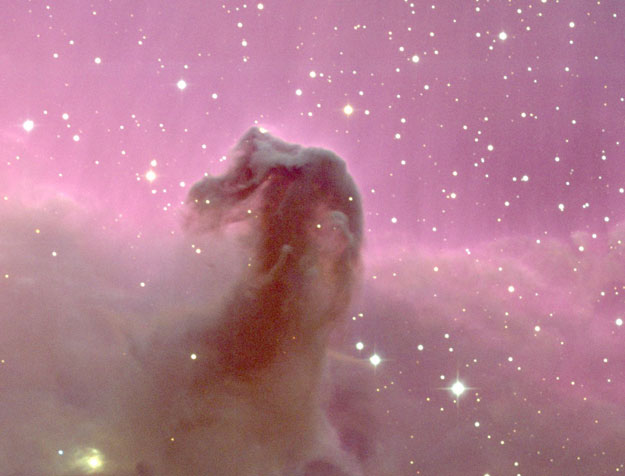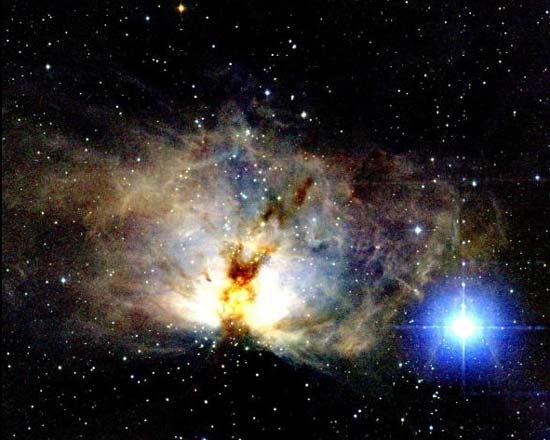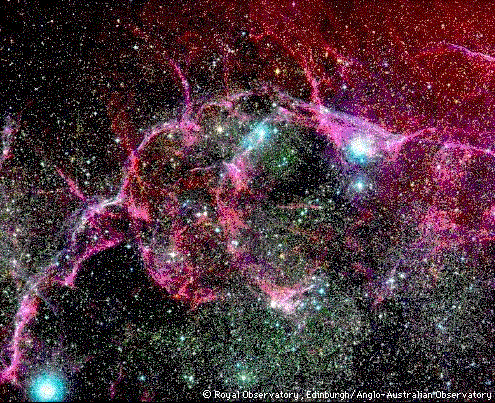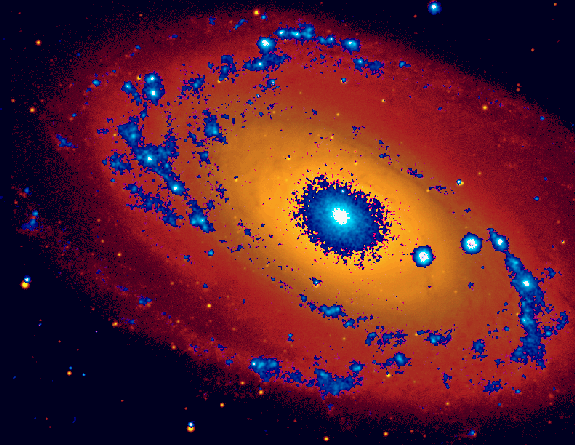| << Previous | Index | Next >> |
2015 Pluto surface is strange. As the robotic New Horizons barrels toward its closest approach to Pluto and its moons tomorrow, images already coming back show Pluto's surface to be curiouser and curiouser. The featured image, taken two days ago, shows the side of Pluto that always faces Pluto's largest moon Charon. Particularly noteworthy is the dark belt near the bottom that circles Pluto's equator. It is currently unclear whether regions in this dark belt are mountainous or flat, why boundaries are so sharply defined, and why the light regions seem to be nearly evenly spaced. As New Horizons will be flying past the other side of Pluto, this should be the best image of this distant landscape that humanity sees for a long time. Assuming the robotic spacecraft operates as hoped, images taken of the other side of Pluto, taken near closest approach, will be about 300 times more detailed.
2014 NGC 2818 is a beautiful planetary nebula, the gaseous shroud of a dying sun-like star. It could well offer a glimpse of the future that awaits our own Sun after spending another 5 billion years or so steadily using up hydrogen at its core, and then finally helium, as fuel for nuclear fusion. Curiously, NGC 2818 seems to lie within an open star cluster, NGC 2818A, that is some 10,000 light-years distant toward the southern constellation Pyxis (the Compass). At the distance of the star cluster, the nebula would be about 4 light-years across. But accurate velocity measurements show that the nebula's own velocity is very different from the cluster's member stars. The result is strong evidence that NGC 2818 is only by chance found along the line of sight to the star cluster and so may not share the cluster's distance or age. The Hubble image is a composite of exposures through narrow-band filters, presenting emission from nitrogen, hydrogen, and oxygen atoms in the nebula as red, green, and blue hues.
2013 Reddened rays of the setting Sun flooded the skies over Cedar Creek Lake, southeast of Dallas, Texas, planet Earth on July 6th. And while sunsets may be the most watched celestial event, this one even offered something extra. A sunspot so large it was visible to the naked eye is captured in the serene sunset view, near the center of a solar disk dimmed and distorted by Earth's dense atomosphere. Telescopic views revealed the spot to be a complex of large solar active regions composed of sunspots, some larger than planet Earth itself.
2012 One of the last entries in Charles Messier's famous catalog, big, beautiful spiral galaxy M101 is definitely not one of the least. About 170,000 light-years across, this galaxy is enormous, almost twice the size of our own Milky Way Galaxy. M101 was also one of the original spiral nebulae observed with Lord Rosse's large 19th century telescope, the Leviathan of Parsontown. In contrast, this multiwavelength view of the large island universe is a composite of images recorded by space-based telescopes in the 21st century. Color coded from X-rays to infrared wavelengths (high to low energies), the image data was taken from the Chandra X-ray Observatory (purple), the Galaxy Evolution Explorer ( blue), Hubble Space Telescope(yellow), and the Spitzer Space Telescope(red). While the X-ray data trace the location of multimillion degree gas around M101's exploded stars and neutron star and black hole binary star systems, the lower energy data follow the stars and dust that define M101's grand spiral arms. Also known as the Pinwheel Galaxy, M101 lies within the boundaries of the northern constellation Ursa Major, about 25 million light-years away.
2011 For the last time, the US Space Shuttle has approached the International Space Station (ISS). Following a dramatic launch from Cape Canaveral last week that was witnessed by an estimated one million people, Space Shuttle Atlantis on STS-135 lifted a small crew to a welcome rendezvous three days ago with the orbiting station. Although NASA is discontinuing the aging shuttle fleet, NASA astronauts in the near future will be able to visit the ISS on Russian space flights. Pictured above, Atlantis rises toward the ISS with its cargo bay doors open, showing a gleaming metallic Raffaello Multi-Purpose Logistics Module. Over 200 kilometers below lie the cool blue waters of planet Earth. The much-anticipated last glide back to Earth for the Space Shuttle is currently scheduled for next Thursday, July 21.
2010
[imghover6=http://apod.nasa.gov/apod/image/1007/bl ... venson.jpg]http://apod.nasa.gov/apod/image/1007/bl ... ollo17.jpg[/imghover6]Credit: Apollo 17 Crew, NASA; Photographic Mosaic & Digital Copyright: Rob Stevenson
2009 A volcano on Krakatoa is still erupting. Perhaps most famous for the powerfully explosive eruption in 1883 that killed tens of thousands of people, ash from a violent eruption might also have temporarily altered Earth's climate as long as 1500 years ago. In 1927, eruptions caused smaller Anak Krakatau to rise from the sea, and the emerging volcanic island continues to grow at an average rate of 2 cm per day. The latest eruption of Anak Krakatau started in 2008 April and continues today. In this picture, Anak Krakatau is seen erupting from Rakata, the main island of the Krakatoai group. High above, stars including the Big Dipper are clearly apparent.
2008 This eerie glow over Death Valley is in danger. Scrolling right will show a spectacular view from one of the darkest places left in the continental USA: Death Valley, California. The above 360-degree full-sky panorama is a composite of 30 images taken two years ago in Racetrack Playa. The image has been digitally processed and increasingly stretched at high altitudes to make it rectangular. In the foreground on the image right is an unusually placed rock that was pushed by high winds onto Racetrack Playa after a slick rain. In the background is a majestic night sky, featuring thousands of stars and many constellations. The arch across the middle is the central band of our Milky Way Galaxy. Light pollution is threatening dark skies like this all across the US and the world, and therefore the International Dark-Sky Association and the US National Parks Service are suggesting methods that can protect them.
2007 Today, if it is clear, well placed New Yorkers can go outside at sunset and watch their city act like a modern version of Stonehenge. Manhattan will flood dramatically with sunlight just as the Sun sets precisely on the centreline of every street. Usually, the tall buildings that line the gridded streets of New York City's tallest borough will hide the setting Sun. This effect makes Manhattan a type of modern Stonehenge, although only aligned to about 30 degrees east of north. Were Manhattan's road grid perfectly aligned to east and west, today's effect would occur on the Vernal and Autumnal Equinox, March 21 and September 21, the only two days that the Sun rises and sets due east and west. Pictured above in this horizontally stretched image, the Sun sets down 34th Street as viewed from Park Avenue. If today's sunset is hidden by clouds do not despair -- the same thing happens twice each year, in late May and mid July. On none of these occasions, however, should you ever look directly at the Sun.
2006 You are going into space. New small cameras allow anyone with a web browser to virtually ride along with the space shuttle, at times from numerous angles, as it launches into Earth orbit. Small cameras mounted on the tall thin solid rocket boosters have captured last week's launch of the Space Shuttle Discovery from a unique perspective and in fascinating detail. The above movie picks up just before the space shuttle separated from the thin boosters. The tiles on the bottom of the shuttle are clearly visible. As the movie progresses, the shuttle Discovery and its brown external fuel tank break away from the boosters and continue onward and upward. The new cameras not only make cool movies -- they help NASA monitor details of its shuttle launches better, with the promise of making future rocket launches safer and more efficient.
2005 An analemma is that figure-8 curve you get when you mark the position of the Sun at the same time each day for one year. But the trick to imaging an analemma of the Moon is to understand that on average the Moon returns to the same position in the sky about 51 minutes later each day. So, if you photograph the Moon 51 minutes later on successive days, over one lunation or lunar month it will trace out an analemma-like curve as the actual position of the Moon wanders compared to the average -- due to the Moon's tilted and elliptical orbit. For this excellent demonstration of the lunar analemma, astronomer Rich Richins chose the lunar month containing this year's northern hemisphere summer solstice. The southernmost Full Moon rises at the lower right above the Organ Mountains in southern New Mexico, USA, with the New Moon phase at the upper left. The multiple exposure image required some digital manipulation, particularly to include thin crescent phases in daytime skies.
2004 The Great Nebula in Orion, an immense, nearby starbirth region, is arguably the most famous of all astronomical nebulae. The Orion Nebula, also known as M42, is shown above through ultraviolet and blue filters augmented with three exact colors specifically emitted by hydrogen, oxygen, and sulfur. In addition to housing a bright open cluster of stars known as the Trapezium, the Orion Nebula contains many stellar nurseries. These nurseries contain glowing gas, hot young stars, proplyds, and stellar jets spewing material at high speeds. Many of the filamentary structures visible in this image are actually shock waves - fronts where fast moving material encounters slow moving gas. The Orion Nebula spans about 40 light years and is located about 1500 light years away in the same spiral arm of our Galaxy as the Sun.
2003 One of the most identifiable nebulae in the sky, the Horsehead Nebula in Orion, is part of a large, dark, molecular cloud. Also known as Barnard 33, the unusual shape was first discovered on a photographic plate in the late 1800s. The red glow originates from hydrogen gas predominantly behind the nebula, ionized by the nearby bright star Sigma Orionis. The darkness of the Horsehead is caused mostly by thick dust, although the lower part of the Horsehead's neck casts a shadow to the left. Streams of gas leaving the nebula are funneled by a strong magnetic field. Bright spots in the Horsehead Nebula's base are young stars just in the process of forming. Light takes about 1500 years to reach us from the Horsehead Nebula. The above image was taken with the 0.9-meter telescope at Kitt Peak National Observatory.
2002 This weekend's stereo picture finds Apollo 12 astronaut Pete Conrad standing on the lunar surface near the southern rim of Surveyor Crater in November of 1969. With red/blue glasses you can gaze beyond the spacesuited Conrad across the magnificent desolation of the Moon's Ocean of Storms. Conrad stands next to large chunks of loose rock, debris from the small impact crater. A sampling scoop is in his right hand and a specially designed tool carrier rests by his left foot as he poses for the picture. His photographer, fellow astronaut Al Bean, captured two separate images (cataloged as AS12-49-7318 and AS12-49-7319) by doing something like a stereo "cha-cha" ... taking the first picture while resting his weight on his right foot and the second after shifting to his left. With the first tinted blue and second red, the pair of pictures were offset and combined to create a 3D anaglyph. Donning red/blue glasses allows the result to be viewed with stereo vision.
2001 The most detailed proposal so far for a hotel and resort destination on the Moon (!) has been prepared by Dutch architect Hans-Jurgen Rombaut. The harsh lunar environment posed serious design challenges but the Moon's low, one-sixth-Earth gravity, and the absence of wind were an architectural boon allowing a much more slender and fragile-looking building than would have been possible on Earth. Illustrated here, the structure's two 160 meter high needle-like towers soar over the rim of a deep canyon as planet Earth hangs in the lunar sky. To shield the interior, Rombaut designed 50 centimeter thick walls with two outer layers of Moon rock and a 35 centimeter layer of water held between glass planes. The water absorbs energetic cosmic rays and along with the rock helps keep the temperature constant. Windows are framed as holes in the rock layers. Construction materials are intended to be manufactured on the Moon itself. This Moon Hotel design is welcomed by the international Lunar Explorers Society, LUNEX, who hope to construct a robotic Moon base by 2015, ultimately supporting a lunar village by 2040.
2000 The tiny spot circled on the right actually represents a big astronomical discovery -- the first detected flare from a failed star. Failed stars, termed brown dwarfs in astronomers' parlance, are too low in mass to ignite nuclear hydrogen burning in their cores, yet still shine feebly as the energy from their gravitational collapse is converted to heat and light. In fact, the dim brown dwarf cataloged as LP944-20 is estimated to have only 6 percent the mass of the Sun (60 times the mass of Jupiter) and one-tenth the Sun's diameter. A mere 16 light-years distant in the southern constellation Fornax it is well studied, but this failed star recently startled astronomers by producing a flare visible at x-ray energies. The above Chandra X-ray Observatory images of the LP944-20 star field were recorded in December 1999. Showing nothing (left) for the first nine hours, the brown dwarf generated a significant x-ray flare during the final hours of the observation. How did a failed star produced such a high-energy flare? Magnetic fields twisted and broken by turbulent motions near the surface of the brown dwarf may be the culprit. Difficult to detect because they are otherwise faint, brown dwarf stars are believed to be common throughout the galaxy.
1999 What lights up the Flame Nebula? Fifteen hundred light years away towards the constellation of Orion lies a nebula which, from its glow and dark dust lanes, appears like a billowing fire. But fire, the rapid acquisition of oxygen, is not what makes this Flame glow. Rather the bright star Alnitak, the easternmost star in the Belt of Orion visible to the nebula's right, shines energetic light into the Flame that knocks electrons away from the great clouds of hydrogen gas that reside there. Much of the glow results when the electrons and ionized hydrogen recombine. The above false-color picture of the Flame Nebula (NGC 2024) was taken in infrared light, where a young star cluster becomes visible. The Flame Nebula is part of the Orion Molecular Cloud Complex, a star-forming region that includes the famous Horsehead Nebula.
1998 In the old days, just over a year ago, astronomers had little idea of the true distance to gamma-ray bursts. Did these enigmatic explosions occur in our outer Galaxy, or in the outer Universe? Last May, a first telling distance measure was made - GRB 970508 showed an absorption line with a redshift of about 0.8 - indicating that this gamma-ray burst (GRB) was an enormous distance away. Skeptics, however, are not always convinced by an unrepeated measurement. Since then, though, other tantalizing coincidences have occurred: GRB 971214 occurred unusually near a galaxy with the enormous redshift of 3.4, and GRB 980425 occurred unusually near a peculiar low-redshift supernova. Skeptics were intrigued. Now, the potentially definitive implications of the above-pictured optical transient might impress even the cautious. GRB 980703's optical transient shows a well-measured redshift from both an absorption line and an emission line: 0.97. The above negative highlights the uncommon transient source with the label "OT", while letters designate common comparison stars.
1997
1996 Few stars are still forming in the old giant spiral galaxy M81. The blue regions in this picture - representing ultraviolet light - highlight regions of bright young stars and star formation and appear rare than in M74 and M33. The red regions - representing the visible light - show a large population of older, less massive stars. M81 is therefore classified as spiral galaxy type "Sab" on the Hubble Sequence of Galaxies. One distinguishing feature of these types of galaxies is the relatively large central bulge surrounding the center of the galaxy. A massive density wave circulates around the center of spiral galaxies. It is not well understood why the bulge of M81 glows as bright as it does in ultraviolet light. Speculation includes that this may be due to hot evolved stars such as those found in the ancient globular cluster Omega Centauri.
1995 Comet Shoemaker-Levy 9, named after its co-discoverers, was often referred to as the "string of pearls" comet. It is famous for its unusual appearance as well as its collision with the planet Jupiter! The comet's original single nucleus was torn to pieces by Jupiter's strong gravity during a close encounter with the solar system's largest planet in 1992. The pieces are seen in this composite of Hubble Space Telescope images to be "pearls" strung out along the comet's orbital path. In July of 1994 these pieces collided with Jupiter in a unique and spectacular series of events.
| << Previous | Index | Next >> |
